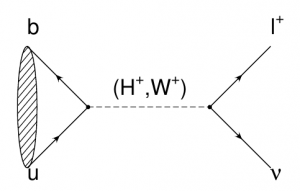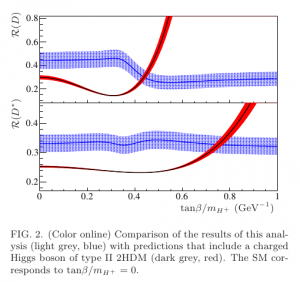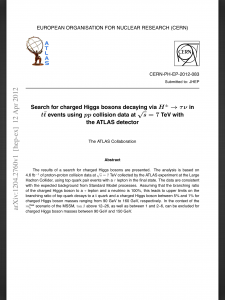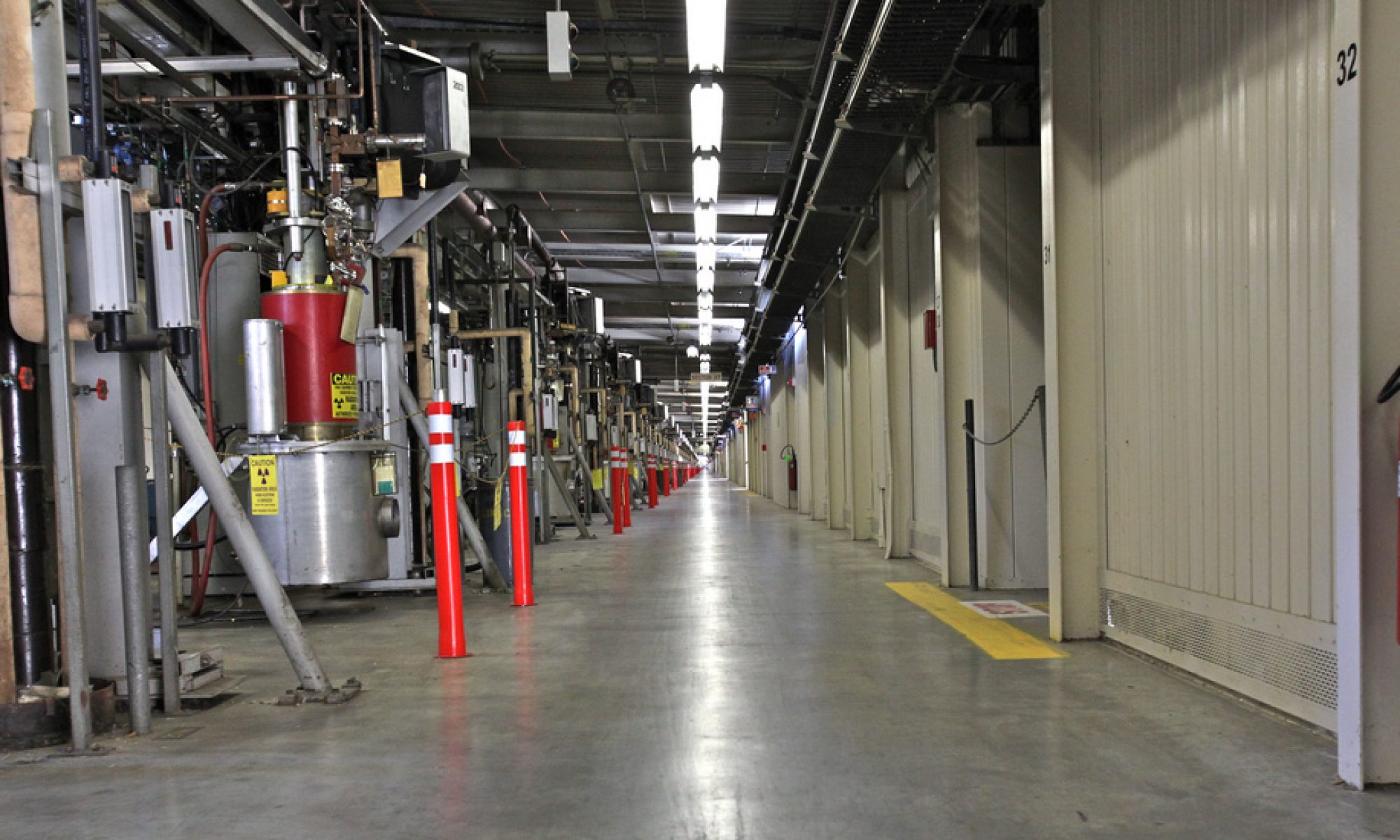I was once given a piece of advice: never work on your thesis project for too long. Whether I meant to or not, I did not follow that advice. It has not been a bad thing at all.
B → τ ν
My Ph.D. Thesis was entitled “A Search for B → τ ν Recoiling against B → D0 ℓ ν X”, and detailed the first use of events where charged B mesons have been produced in pairs, one of them decays to a “tagging” mode (which “tags” the event as a two-B-decay event) involving a D0 meson, a lepton, and a neutrino, and the other B meson is studied for consistency with the decay B → τ ν. Quantum mechanically, through the Feynman Diagram Representation, this process can be imagined as follows:

The anti-bottom and the up quark are joined in a bound state by an intermediating gluon field (the gray oval). Their wave functions are extended in space and overlap; the degree of overlap is known as the B meson “decay constant.” The larger the decay constant, the larger the wave functions overlap, and the more like the quarks will suffer an interaction through the Weak Force. If such an interaction occurs, then the quarks will annihilate through a W+ vector boson in the Standard Model. The W+ is then free to decay to any allowed final state, such as the tau lepton and the tau neutrino.
Theories of nature that contain additional Higgs fields (in order to give mass to other particles in nature than those described by the Standard Model – dark matter, for instance) often contain electrically charged Higgs bosons. In fact, adding even one additional Higgs field doublet automatically generates 5 physical Higgs boson states, two of which are electrically charged (H+ and H-). Such a boson can additionally mediate this decay, as depicted above, and can enhance or suppress the rate of the decay by interfering constructively or destructively with the W+ boson.
My thesis did not turn up convincing evidence for this process. It was only years later, in 2009, that the BaBar Collaboration published a more convincing paper on this subject (that paper was the result of a Ph.D. thesis from a student at The Ohio State University with whom I worked closely, and who was mentored by his advisor from OSU, another post-doc in the group, and me). In that paper, we reported a measurement of the rate of this decay of (1.7 +/- 0.8 +/- 0.2) x 10-4, excluding a rate of zero at 2.3σ. In addition, one other independent measurement from the BaBar Collaboration using a non-overlapping technique, and two papers from the Belle Collaboration, all combine together to demonstrate (1) a non-zero rate for this process and (2) an excess above what is expected from only the Standard Model of Particle Physics. These papers are available in Ref. 1-4.
There is a related B meson decay, B → D(*) τ ν which is similarly sensitive to the interference of a W+ boson and a H+ boson if there is an H+ in nature.
B → D(*) τ ν
Both the Belle and BaBar Collaborations have measured this decay process [5,6]. The BaBar authors present stronger evidence for the process than the Belle publication (which preceded the most recent BaBar paper by about two years). They also find a hint that the process is, like B → τ ν, occurring at a rate higher than predicted by the Standard Model. From that evidence they also conclude that at least one model of an extended Higgs sector – the so-called “Type-II Two-Higgs-Doublet Model (2HDM),” is excluded at greater than 99% confidence level. That is because the interpretation of the excesses in the two final states – D and D* – is STRONGLY INCONSISTENT in the Type-II 2HDM model. You cannot explain the excesses in both channels using that particular model.
The plots below, taken from the BaBar paper, illustrate the problem beautifully. In the Type-II 2HDM, there should be a single value of the parameter tan(beta)/MH; however, you get a two-valued solution when applying the model to these two decay modes. The red and blue should intersect at the same locations in the top and bottom plots; they do not.

What can be said?
The most honest interpretation, one that is not slave to a specific model, is simply this: the Standard Model of Particle Physics is not good at predicting the rate at which heavy flavor (B mesons) decays to tau leptons and tau neutrinos. That is what the data tells us. Everything else is interpretation within a set of assumptions.
But all of this begs the question: if Nature’s production rate of tau lepton and neutrino from decay is excessive, but only when considering heavy flavor decays, what should be be looking for? Here, the assumption can be made that whatever the cause, it has something to do either with generation (bottom quarks but not charm quarks) or mass (heavy quarks at the level of the bottom, but not for lighter quarks), or both.
Certainly, a Higgs-like thing with an electric charge fits the bill. The H+ and H- provide both a mass-dependent coupling and an electric charge.
Direct Searches for a Charged Higgs Boson at High Energy

Like their predecessors at the LEP and Tevatron experiments, many physicists on both the ATLAS and CMS experiments are engaged in direct searches for a charged Higgs boson – predicted by any model – at the highest possible energies [7, 8]. If what is happening at low energy is to be explicable by the existence of a charged Higgs boson, one must find direct evidence for it.
I have been very excited to be part of the ATLAS team investigating the existence of this particle. For the time being, we have used an established technique to hunt for the H+. We begin with events that are consistent with pp -> top anti-top + X, where “X” could be nothing or (more likely) could be additional by-products of proton collisions. We then look for one top to decay to Wb, the favored and most prevalent Standard Model decay channel. We then see if the other one has also decayed to Wb, or it (instead) it has decayed to Hb, where a charged Higgs replaces the W boson.
Using 4.6 inverse femtobarns of data (the entire 2011 sample available with our triggers in place), we found no evidence for t -> Hb and instead set the most stringent limits to date on the production of a charged Higgs from top quark decay. This is a moment of joy and frustration. We overcame many challenges to achieve an unprecedented sensitivity; for some Higgs masses we achieved a sensitivity of 1% on the product of the rates at which t -> Hb and H -> tau nu. On the other hand, we didn’t see evidence for anything new in the process.
And so?
At least one recent paper by some theoretical physics colleagues [9] illustrates how one can modify assumptions about the Higgs structure and constrain the Higgs sector using the low-energy measurements. This paper provides some sign-posts on where ATLAS and CMS may want to look next. Certainly, the hunt is on. As always, the question facing us is simple: is this a blind alley? We’re going to have to walk it a but further to find out.
[1] A Search for B+ —> l+ nu(l) Recoiling Against B- —> D0 l- nu-bar X. BABAR Collaboration (Bernard Aubert (Annecy, LAPP) et al.). Dec 2009. Phys.Rev. D81 (2010) 051101. e-Print: arXiv:0912.2453 [hep-ex]
[2] Evidence for B+−>τ+ντ decays using hadronic B tags. BABAR Collaboration (P. del Amo Sanchez (Annecy, LAPP) et al.). Aug 2010. Contributed to 35th International Conference on High Energy Physics, July 22-28, Paris (ICHEP 2010). e-Print: arXiv:1008.0104 [hep-ex]
[3] Evidence of the Purely Leptonic Decay B- —> tau- anti-nu(tau) – Belle Collaboration (Ikado, K. et al.) Phys.Rev.Lett. 97 (2006) 251802 . hep-ex/0604018 .
[4] Evidence for B−−>τ−νˉ with a Semileptonic Tagging Method – Belle Collaboration (Hara, K. et al.) Phys.Rev. D82 (2010) 071101 . arXiv:1006.4201 [hep-ex] .
[5] Observation of B+ -> Dbar*0 tau+ nu_tau and Evidence for B+ -> Dbar^0 tau+ nu_tau at Belle – Belle Collaboration (Bozek, A. et al.) Phys.Rev. D82 (2010) 072005 . arXiv:1005.2302 [hep-ex]
[6] Evidence for an excess of B -> D(*) Tau Nu decays. BaBar Collaboration. May 2012. e-Print: arXiv:1205.5442 [hep-ex]
[7] Search for charged Higgs bosons decaying via H+ -> tau nu in top quark pair events using pp collision data at sqrt(s) = 7 TeV with the ATLAS detector.
ATLAS Collaboration (Georges Aad (Freiburg U.) et al.). Apr 2012. Published in JHEP 1206 (2012) 039. e-Print: arXiv:1204.2760 [hep-ex]
[8] Search for a light charged Higgs boson in top quark decays in pp collisions at sqrt(s) = 7 TeV. CMS Collaboration (Serguei Chatrchyan (Yerevan Phys. Inst.) et al.). May 2012. Submitted to the Journal of High Energy Physics. e-Print: arXiv:1205.5736 [hep-ex]
[9] Explaining B->D\tau\nu, B->D*\tau\nu and B->\tau\nu in a 2HDM of type III.
Andreas Crivellin, Christoph Greub, Ahmet Kokulu. Jun 2012. e-Print: arXiv:1206.2634 [hep-ph]

